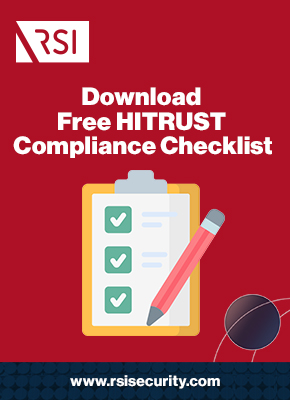In 2007, the Health Information Trust Alliance (HITRUST) took the world of healthcare security by storm when it introduced a framework that does not only protect sensitive information but also manage risks for global organizations across third-party supply chains.
Technically-speaking, the HITRUST Common Security Framework (CSF) characterizes and transforms HITECH and HIPAA requirements into a standard functional procedure which is subsequently documented and compared to other data privacy and security regulations.
This allows healthcare organizations to effectively cultivate compliance and be able to meet an extensive range of regulatory requirements. Apart from bringing together HIPAA and HITECH, the HITRUST CSF also boasts globally-recognized security standards such as PCI, COBIT, FTC, ISO, Red Flags, and NIST which work together to take a visionary approach to risk mitigation and data protection.
Background on the HITRUST CSF Framework
The HITRUST framework allows organizations to safeguard Protected Healthcare Information (PHI) of patients. This move quintessentially drives loyalty from customers knowing that you put their privacy and security above everything.
More specifically, HITRUST CSF requires organizations to ensure that healthcare companies contingent on HIPAA and their third-party business associates meet the standards. Without CSF, digital products that are in compliance with HIPAA can often be daunting to execute.
Like it or not, many people consider compliance as something you just have to do to operate within a specific vertical market. Also, businesses often believe doing security right means you are compliant. It is, however, untrue and only represents compliance as a liability rather than an asset to be utilized for competitive advantage.
In this comprehensive guide, we will walk you through the methodologies and scoring structure as well as implementation requirements of HITRUST to optimize compliance posture. For an organization to effectively evaluate possible risks and develop adequate protection, HITRUST has come up with an all-encyclopedic risk management framework that supports a basic four-step process.
Among these processes include being able to recognize risks and characterize the requirements needed for protection as well as specifying, implementing, and managing controls. The risk management framework also assesses cyber threats and timely reports to avoid irreparable damage.
Assess your HITRUST compliance
Different HITRUST Implementation Requirements
With attacks happening every 39 seconds, being HITRUST compliant is more important than ever. Organizations which develops, stores, and distributes personal data over different networks must be able to comply with HITRUST requirements to address a myriad of national and global regulatory guidelines.
Presently, more than 84% of health organizations and businesses utilize the CSF, making it the most extensively espoused security framework in the industry. With a framework similar to ISO 27001, HITRUST CSF is comprised of 149 system controls and up to three implementation levels.
Generally, HITRUST implementation levels are based upon the three unique factors that include organizational, system, and regulatory factors. Besides that, HITRUST also designated three distinctive risk levels that are primarily dependent on risk systems and complexity within the organization.
- Level 1: In most cases, level 1 is the minimum security requirement for any system of all business sizes. This level also serves as the industry barometer by meeting all the requirements.
- Level 2: The second level, on the other hand, offers all the functionality of Level 1 but with additional control and strength. It is, however, essential to note that Level 2 is only needed for an organization that suffers increased system risk due to the complexity of regulatory, system, and organization factors.
- Level 3: Level 3 is equipped with better implementation power than the previous levels and can only be used depending on the intricacy and density of the risk.

How Does HITRUST Scoring Work?
Being HITRUST certified takes a lot of work. Estimates show that the assessment stage alone can last for as little as two weeks to as long as eight weeks depending upon the complicacy of the scope environment and the organization itself. Also, companies that are CSF-certified by HITRUST are required to make use of the right protocols and technologies, or otherwise, they lose their certification.
While obtaining HITRUST CSF certification can be challenging, the rewards that come with it are worth the energy and effort. Initially, an organization must first be able to score their control environment compliance with the HITRUST CSF maturity model to execute an assessment.
More often than not, the maturity model is used by reputable consultative firms like RSI Security to thoroughly assess and score both the Self-Assessments and Validated Assessments. Having a full grasp of the complexities of the HITRUST maturity model is important not only in rating compliance controls but also in corroborating and certifying your validated scoring and assessment.
Put simply, the HITRUST maturity model necessitates that each organizational controls are evaluated in five unique areas specifically measured, managed, policies, process, and procedures, and implemented. It should be noted that approximately 75% of the overall score comes from the policy, implemented, and procedural levels.
This is because the most important aspect is that controls have to be documented in the procedure and policy to make sure that people know how to implement and prove that it is effective. Managed and measured, levels, meanwhile are designed for organizations that have systems in place to quantify the performance of a specific control.
In simplest terms, HITRUST scoring primarily emphasizes that if you can show well-documented procedures and policies and efficient control implementation to meet requirements, those controls are deemed compliant. While there might be a requirement for measured and managed to reach certain levels, it is far more important to ensure that policy, procedures, and implementation is addressed to a tee to easily achieve HITRUST certification.
The following is how HITRUST succinctly outlines the five areas and the overall criteria that can be utilized to assess specific compliance levels.
- Policy (25%). In the policy section, HIPAA evaluates as to whether all the existing policies and standards cover the major operations and facilities of the organization. It is also in this area where HITRUST evaluates effective communication between business leaders and their entire workforce when it comes to transmitting policies and standards correctly.
- Procedures (25%). Similarly, HITRUST also analyzes whether the procedures for implementation of each element of requirements were communicated to individuals who are required to follow them. This is HITRUST’s way of ensuring that people assigned are well-versed enough to do the tasks.
- Implemented (25%). In the implemented section, HITRUST along with a certified CSF firm like RSI Security will assess as to whether your organization consistently implements your procedures and policies everywhere. Addedly, ad hoc approaches are also scrutinized to identify if it is applied on a case-by-case basis or individually.
- Measured (15%). The measured rubric of the HITRUST CSF system significantly refers to the routine audits and self-assessments that were performed or metrics collected to figure out the effectiveness and adequacy of the implementation. Likewise, this also evaluates the frequency and rigor in which every element of the requirements is assessed based on the threats it poses.
- Managed (10%). The managed category, meanwhile, alludes to the corrective actions that were taken to solve the identified weaknesses in the elements of the requirements statements. In most cases, these corrective actions are also assessed based on the risk, mission impact, and costs. This is an essential way of knowing how the threats affect the requirements periodically.
How are HITRUST Scores Calculated?
It is relatively noticeable that each level of the HITRUST CSF maturity model develops on the previous in a rhythm of sustained improvement. This particular process is often considered to be the nucleus of a prosperous information security management system.
Maturity levels range from non-compliant, somewhat compliant, and partially compliant to mostly compliant and fully compliant. Always keep in mind that businesses should at least have an overall rating of 62% or greater to obtain a certification.
For self-assessment and validated assessment, businesses are required to designate a maturity level in the MYCSF tool for their control and compliance with the five aspects of the HITRUST CSF maturity model. It is, however, fundamental to bear in mind that HITRUST calculates the overall rating of an organization by multiplying the sum of the five weight maturity levels and the maturity level rating for all the model levels.
Maturity level ratings range from one to five with each domain requiring a score of three to reach the passing grade. HITRUST will only issue a validated report if one or more domains received a grade that is lower than three.
Nonetheless, businesses can still obtain HITRUST certification by preparing a corrective action plan on the controls that did not receive a rating of three. Overall, HITRUST requires businesses to meet 64 controls to be recognized with a CSF certification.

Reasons to Getting Certified Today
As you can see, getting a CSF certification from HITRUST means arduous work not to mention the price that is associated with the whole procedure. It should be noted, however, that the lack of compliance can ultimately lead to destructive consequences for the company. HITRUST is the future and here are the reasons why you should get it in the soonest possible time.
- It Reduces Cyber-Related Risks
Hackers are becoming smart, and they continue to find innovative ways to tweak their methods. Being HITRUST compliant keeps organizations familiar with the new tactics of hackers, thus, enabling them to calibrate their systems for maximum security.
While acquiring a HITRUST certification does not come cheap, doing so not only helps asseverate robust security of patient data and other proprietary information but also enhances business programs in terms of accuracy, consistency, and efficiency. Interestingly enough, reports by Allied World U.S. further indicated that HITRUST certification enabled a more centralized application process.
- HITRUST CSF Makes Everything Reproducible
Unlike other security systems, HITRUST CSF appears as a guideline for risk management processes, making them repeatable so everything can be done each time accurately. The entire process is adjacently documented so businesses that keep sensitive data can benefit from following its roadmap. This is an optimal way of speeding up monotonous business processes so that your organization can focus on providing excellent patient care.
Along with its ability to document sensitive data is HITRUST CFS uncanny ability to adapt to emerging security threats and cyberattacks thanks to its ongoing assessments. With an endless approach to review and improvement, CSF is the prime way for organizations to put their best foot forward in an ever-changing healthcare landscape.
- Stand Out from Competitors
In a pressure-packed environment of healthcare where everybody seems to be screaming their lungs out from their rooftops, standing out among competitors is essential in driving more revenue.
With HITRUST, businesses can stand out from their fierce competitors as the whole framework reduces the time and costs spent on putting together all requirements into one place to identify risk and maturity.
Moreover, HITRUST also prevents issues relating to the second audit since you will be able to view security and compliance matters in a centralized location. On top of that, HITRUST further helps businesses leverage their prestige and credibility in acquiring potential customers.
Closing Thoughts
The CSF assessment is lengthy because it is starting to become the gold standard for ISO and HIPAA compliance. Plus, HITRUST specialists also deal with a massive backlog of requests. So, it is important to work with a worthy and qualified assessor to make the process even easier.
Also, be mindful of the fact that business organizations undergo HITRUST re-certifications annually to stay up-to-date with the latest security measures. Hiring assessors like RSI Security, who has an excellent track record of delivery will help your organization maintain brand recognition and avoid potential lawsuits.
As an authorized assessor, RSI Security is adept at helping businesses achieve their needs for HITRUST compliance. Arrange a consultation with one of our experts so we can walk you through the basics of the compliance and the certification process.
Download Our HITRUST Compliance Checklist
Assess where your organization currently stands with being HITRUST compliant by completing this checklist. Upon filling out this brief form you will receive the checklist via email.

